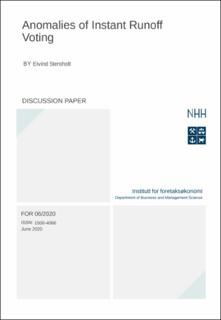Anomalies of Instant Runoff Voting
Working paper

Åpne
Permanent lenke
https://hdl.handle.net/11250/2659146Utgivelsesdato
2020-06-23Metadata
Vis full innførselSamlinger
- Discussion papers (FOR) [566]
Sammendrag
Struggles over the single-seat preferential election method IRV (Instant Runoff Voting) go on in public arenas and scientific journals, with focus on two “anomalies”. “Monotonicity failures” are preference distributions that allow a startling strategic voting called Pushover or its reverse. Analysis shows how a Pushover action works, and why it is hard to predict and exploit an opportunity. While not rare, monotonicity failures should be seen as a minor nuisance.
“No-Show paradoxes” are alarms. The IRV tally eliminates a very clear Condorcet winner in a realistic, but somewhat unusual preference structure, too close to Duncan Black’s Single- Peak condition: Too many YXZ-ballots let Z win instead of a very clear Condorcet-winner X who is eliminated; this harms IRV’s legitimacy. Baldwin’s elimination rule when three candidates remain is a suggested remedy.
Preference distributions with the same IRV-tally are grouped together and analyzed with “pictograms” as a tool. That allows a generalization of Black’s Single-Peak condition; real cases are close to “Perfect Pie-sharing”, which explains why Condorcet cycles are rare.